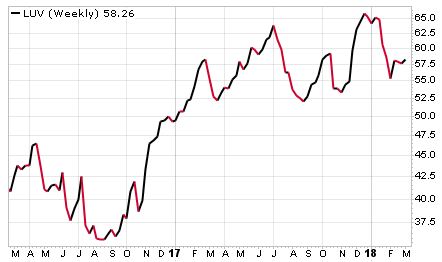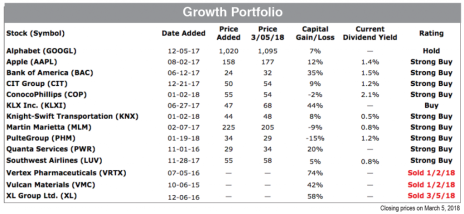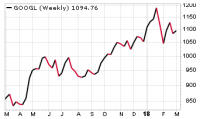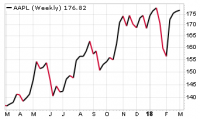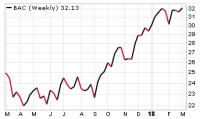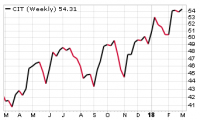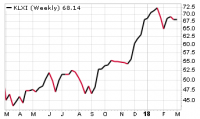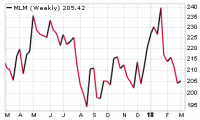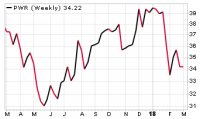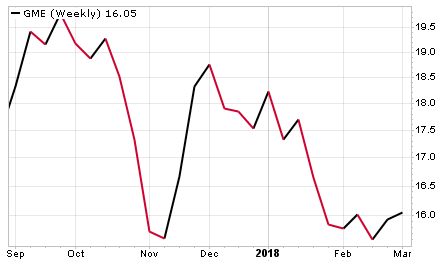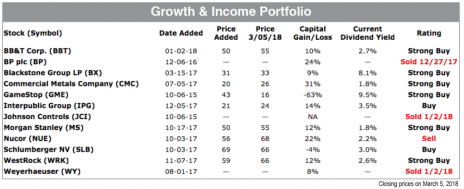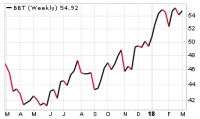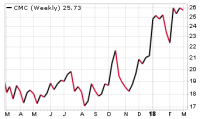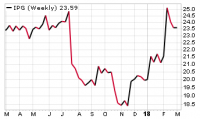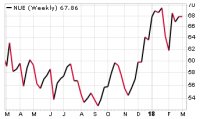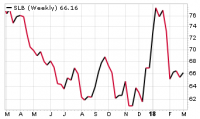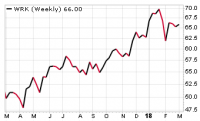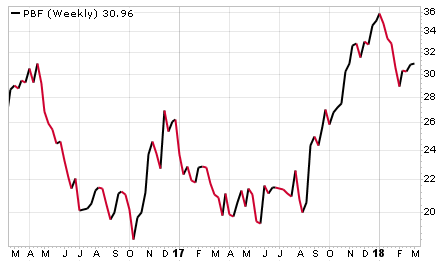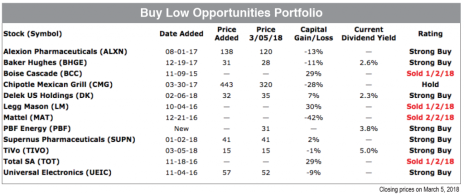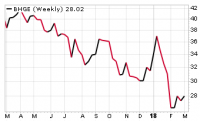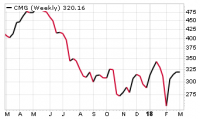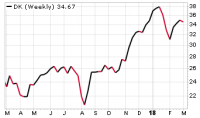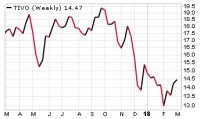Today’s featured stocks include GameStop (GME), Southwest Airlines (LUV) and PBF Energy (PBF), which is joining the Buy Low Opportunities Portfolio. I’m also selling Nucor (NUE) today.
Cabot Undervalued Stocks Advisor 318
[premium_html_toc post_id="146036"]
The Almost-Final Decision on the Section 232 Investigation
As expected, the U.S. government’s Section 232 investigation into the national security implications of international trade abuses in the steel and aluminum industries will likely result in tariffs on imported steel. No surprise there, because the Commerce Department signed off on tariff and/or quota recommendations many weeks ago, and simply awaited a pronouncement from the Office of the President. It has yet to be decided, though, which steel manufacturers or countries will have tariffs imposed upon them. Pertinent decisions will be finalized by April 11. (There is historical precedent that changes are made to these policies in the months following initial implementation, including exempting various steel products from the tariffs.)
Those of you who’ve been reading my occasional comments are aware that this trade investigation has been ongoing for close to a year. Isn’t it interesting how the press erupted on the topic last week, literally as if, out of the blue, President Trump waved a magic wand and arbitrarily declared that the U.S. is closing its doors to China? It’s no wonder that I have no patience for mainstream media. In that light, when you see blustering headlines invoking surprise and retaliation from various steel consumers and foreign countries, you should realize that the new steel tariffs came as no surprise to literally anybody who works in global commerce or has an interest in the steel industry. Lots of what you see in news stories is posturing, often unrelated to truth.
Here’s what I wrote to Cabot Undervalued Stocks Advisor subscribers on May 25, 2017:
This week, the U.S. government announced that it began a Section 232 investigation into the national security implications of steel imports. In English, that means that the new heads of trade and commerce are following through on President Trump’s campaign promise to get tough on trade abuses.
The steel industry has been especially hard hit by illegal dumping (artificially low pricing) by foreign producers. For example, because the Chinese government subsidizes steel companies, those companies do not have to earn a profit to stay in business. They can sell their steel at whatever price they want, purposely undercutting U.S. steel prices to gain market share. U.S. steel companies cannot effectively fight back, because they are required to aim for profitability to stay in business. Steel production in the U.S. fell 27% in 2015, largely due to currency manipulation and trade cheating on the part of Asian countries. (For more information, see my September 2016 article “TPP Portends Death to U.S Steel Industry.”)
The essential question for the Section 232 investigation is whether low prices on steel imports are harming the steel industry enough that the U.S. government needs to attempt to put a stop to the unfair trade practices.
When the President and economists talk about unfair trade practices, it is not a discussion about tariffs, as the news media so often mentions in brief sound bites. It’s a discussion about seriously imbalanced product pricing that’s manipulated by currency devaluations, skirting agreed-upon rules of origin, BAT taxes, VAT taxes, slave labor, government subsidies and more. (FYI, proposing remedies to unfair trade practices was a significant part of my work as a trade advocate in Washington D.C. in 2015 and 2016.)
Since that time, I covered the topic about a dozen times, bringing investors up-to-date on the investigation as it wound its way through the Commerce Department, the Office of the U.S. Trade Representative, industry leaders, and the U.S. International Trade Commission. I point this out because you would never know from reading the histrionics on social media or listening to glamorous communications majors in front of news cameras that there had been any rational investigation at all!
Here’s the weekend’s comment from Commerce Secretary Wilbur Ross, from Inside U.S. Trade:
Ross also said a steel tariff would not, as automakers have alleged, have a significant impact on the price of cars made in the U.S.
“So it’s not a big deal,” he said, adding that it “certainly” should not have led to the stock market declines widely attributed to the tariffs announcement on Thursday—and, he added, the decline in General Motors’ stock in particular. “It’s a tremendous overreaction.”
“All this hysteria is a lot to do about nothing,” Ross added.
The economics team at one major investment bank stated that they do not foresee steel tariffs causing a trade war, and that the tariffs will likely last between 12 and 21 months. Strategies to counter trade abuses are not unheard of. For example, Section 201 tariffs were implemented on some steel imports in 2002, and lasted for 22 months. In fact, many existing trade agreements have been tweaked during the last year, and several trade abuses were addressed with new tariffs and/or quotas, including within the softwood lumber industry.
While I understand that lots of people equate a new steel tariff with partisan politics, I think the question comes down to this: “When someone is breaking rules or taking advantage of you in an obvious and egregious manner, do you allow it, or do you fight back?” I have always been the “fight back” type of person.
Just as certain industries were aided and others were harmed while various forms of trade cheating took place, we’ll likely see a reversal in that those same industries will now be harmed or aided as the trade remedy is implemented. That’s to be expected, right? When you fix problems, you ruffle feathers. Various U.S. steel manufacturers will likely see increases in revenue and profits from this international trade decision. Today I encourage you to add to your positions in Commercial Metals (CMC) and sell Nucor (NUE) because the latter presents a less attractive growth vs. value scenario.
Send questions and comments to crista@cabotwealth.com.
Quarterly Earnings Release Calendar
March 6 am: KLX Inc. (KLXI) – 4Q
Virtually all companies offer extensive information on their websites pertaining to their quarterly earnings releases, often including slide shows or webcasts.
Earnings Season Scorecard
Big Earnings Beat: Alexion Pharmaceuticals (ALXN), BB&T Corp. (BBT), Bank of America (BAC), CIT Group (CIT), Delek US Holdings (DK), Knight-Swift Transportation (KNX), Martin Marietta Materials (MLM), Morgan Stanley (MS), Nucor (NUE), Schlumberger (SLB), Supernus Pharmaceuticals (SUPN), WestRock (WRK) and XL Group (XL).
Slight Earnings Beat: Apple (AAPL), Baker Hughes, a GE Co. (BHGE), Blackstone Group (BX), Chipotle Mexican Grill (CMG), Interpublic Group (IPG) and Quanta Services (PWR).
Earnings in Line with Estimate: ConocoPhillips (COP), PulteGroup (PHM), Southwest Airlines (LUV) and Universal Electronics (UEIC).
Slight Earnings Miss: Alphabet (GOOGL)
Big Earnings Miss: Mattel (MAT)
Portfolio Notes
Be sure to review the February 28 and March 5 Special Bulletins in which I mentioned news, rating changes and/or price action on BB&T Corp. (BBT), Bank of America (BAC), CIT Group (CIT), Delek US Holdings (DK), Morgan Stanley (MS), Supernus Pharmaceuticals (SUPN), TiVo (TIVO) and XL Group (XL).
Buy-Rated Stocks Most Likely* To Rise More Than 5% Near-Term:
Baker Hughes, a GE Co. (BHGE)
Bank of America (BAC)
CIT Group (CIT)
Commercial Metals (CMC)
GameStop (GME)
Supernus Pharmaceuticals (SUPN)
*I can review price charts and make an educated determination about what’s likely to occur, but I will sometimes be wrong. I cannot control the stock market; I can only guide you through it.
Today’s Portfolio Changes:
Commercial Metals (CMC) moves from Buy to Strong Buy.
GameStop (GME) moves from Buy to Strong Buy.
Nucor (NUE) moves from Hold to Sell.
PBF Energy (PBF) joins the Buy Low Opportunities Portfolio as a Strong Buy.
Last Week’s Portfolio Changes:
Alphabet (GOOGL) moved from Strong Buy to Hold.
KLX Inc. (KLXI) moved from Strong Buy to Buy.
Nucor (NUE) moved from Strong Buy to Hold.
TiVo (TIVO) joined the Buy Low Opportunities Portfolio as a Strong Buy.
XL Group (XL) moved from Strong Buy to Buy, then to Sell.
Growth Portfolio
Growth Portfolio stocks have bullish charts, strong projected earnings growth, little or no dividends, low-to-moderate P/Es (price/earnings ratios) and low-to-moderate debt levels.
Featured Stock: Southwest Airlines (LUV - yield 0.8%)
Could Southwest Airlines Be a Takeover Target?
Southwest Airlines (LUV) is the largest U.S. domestic air carrier, transporting over 120 million customers annually to over 100 locations in the U.S., Central America and the Caribbean. Here’s a long Forbes article about the possibility that Warren Buffett might be interested in purchasing Southwest Airlines … the entire company! Buffett’s Berkshire Hathaway (BRK’A) currently owns 8.1% of Southwest’s outstanding shares. He also owns between 7.5% and 9.9% of the outstanding shares of Delta Air Lines (DAL), United Continental Holdings (UAL) and American Airlines Group (AAL). In my February 20 weekly update, I mentioned that Buffett just sold $3.3 billion of his holdings in Phillips 66 (PSX), saying, “Perhaps Buffett is about to make a big purchase…” I don’t necessarily believe that Buffett might buy Southwest Airlines, but it’s an interesting possibility.
There’s one significant problem with the article. Many folks who write about stocks use last year’s earnings per share (EPS) when calculating the price/earnings ratio (P/E). It’s a misleading tactic, and most often used by people who want to make the stock appear to be overvalued. (Using last year’s lower EPS number results in a higher P/E, while using this year’s higher EPS number results in a lower P/E.) Investment professionals use current year EPS when calculating the P/E. Of course, that makes complete sense, because last year is history and this year is live-and-in-color. When you read the article and see that the author cites a P/E of 16.81, please know that the real 2018 P/E is 11.7, which changes the entire tone of the company’s valuation assessment. The 57.81 share price divided by consensus 2018 EPS estimate $4.96 = P/E 11.66.
Analysts expect Southwest’s EPS to grow 41.7% in 2018. The stock is slowly recovering from the recent market correction. There’s approximately 14% upside as LUV retraces its January high of 66. I expect additional capital gains thereafter. Buy LUV now. Strong Buy.
Updates on Growth Portfolio Stocks
Alphabet Cl. A (GOOGL) is the world’s largest internet company. Revenue is derived from Google’s online ads, with the balance coming from the sale of apps, digital content, services, licensing and hardware. Alphabet presented last week at the Morgan Stanley Technology, Media and Telecom Conference (you may access the webcast here). The discussion focused on its long-term growth drivers: cloud, hardware and YouTube.
I will consider GOOGL to be fairly valued when it retraces its January high near 1,190, at which point I will sell so as to make room for a more undervalued stock to join the portfolio. For those of you who want to own GOOGL long term, it’s a high quality aggressive growth stock, and will probably deliver attractive capital gains for years to come. Hold.
Apple (AAPL – yield 1.4%) manufactures a wide range of popular communication and music devices. Fortune just published an update on projections of record sales of the iPhone X and Apple Watch, and Warren Buffett’s large position in the stock. Forbes chimed in by reporting on the potential return of the MacBook Air and the misleading rumors of iPhone X production cuts. When you read gloomy articles about Apple’s product sales, please remember that Apple’s earnings estimates have done nothing but consistently increase for well over a year now. Falling revenue and rising profits don’t usually go hand-in-hand, so you’ve got to ask yourself, “What’s wrong with this picture?” It has become quite fashionable—or braindead—for financial writers to pronounce Apple’s demise with smug superiority. It’s likely a “follow the leader” type of phenomenon among journalists and newscasters. I’m here to report facts. If product sales truly disappoint, it will show up in falling revenue and earnings estimates, and I will switch gears and contemplate exiting the stock. For now, I see nothing but smooth sailing ahead for revenue, profits and share price.
The company is expected to see EPS grow 25.3% in 2018 (September year-end), and the P/E is 14.8. AAPL barely pulled back during last week’s down market, and that’s a strong sign that the stock is going to move higher quite soon. If you’ve been waiting to buy AAPL, it’s time to make a decision. Buy AAPL now, or forever hold your peace. Strong Buy.
Bank of America (BAC – yield 1.5%) is a significantly undervalued growth stock, expected to see EPS grow 36.6% in 2018. Profits are affected by and enhanced by rising interest rates, more so than at other financial companies. The P/E is 12.8. Financial stocks are showing price strength vs. the broader market. BAC could rise past its recent high of 32.5 quite soon. Buy BAC now. Strong Buy.
CIT Group (CIT – yield 1.2%) operates both a bank holding company and a financial holding company that provide financing, leasing and advisory services to small and middle market businesses, consumer markets, and the real estate and railroad industries. CIT is significantly undervalued, and is expected to see EPS grow 31.9% in 2018. The P/E is 13.3. Financial stocks are showing price strength vs. the broader market. CIT began reaching new all-time highs in mid-February. Buy CIT now. Strong Buy.
ConocoPhillips (COP – yield 2.1%) is a global energy exploration and production company. The company is expected to see earnings grow 355% this year, followed by mid-single digit EPS growth in 2019. (If the 2019 number does not improve, I will exit the stock later this year.) There’s 11% upside as COP retraces its January high at 60. The stock could proceed higher thereafter. Strong Buy.
KLX Inc. (KLXI) is an undervalued, small-cap aggressive growth stock in the aerospace and energy services industries. The company will report fourth-quarter 2018 results (January year-end) on the morning of March 6. Wall Street is expecting $0.88 EPS, with a range of $0.87 to $0.90. In the coming year, KLX is expected to see EPS grow 25.3%. The P/E is 17.2.
The company has been approached by several interested buyers. KLX hired Goldman Sachs in December to handle the potential M&A transaction, but there has been no recent news on the topic. Odds are decent that good news will materialize this year. Buy.
Knight-Swift Transportation Holdings (KNX – yield 0.5%) is a truckload carrier formed from the September 2017 merger between Knight Transportation and Swift Transportation Company. The market expects 2018 EPS to grow 65.9%, and the P/E is 21.1. Last week, Baird raised its price target on KNX to 60. The KNX price chart is signaling a near-term breakout. Buy KNX now. Strong Buy.
Martin Marietta Materials (MLM – yield 0.8%) is a supplier of crushed stone, sand, gravel, cement, concrete and asphalt. This aggressive growth stock is fairly valued. MLM appears to be experiencing one more downturn during its recovery from the market correction. The patterns in the price chart look stable to me, and I wouldn’t hesitate to buy low right now. There’s 17% upside for traders as MLM retraces its January high of 240. At that time, I plan to make room for a portfolio stock that’s more undervalued. Strong Buy.
PulteGroup (PHM – yield 1.2%) is a U.S. homebuilder and a very undervalued aggressive growth stock. 2018 EPS projections for PulteGroup have been consistently rising since June 2017, including as recently as mid-February vs. early February. So, despite any negative industry news on interest rates or new home sales that might flash across your news feed, Wall Street analysts still believe that PulteGroup is growing and thriving. At this moment, the consensus 2018 EPS projection is $3.09, reflecting 50% year-over-year growth. The P/E is quite low at 9.4.
Analysts tend to include things like rising interest rates—and their dampening effect on home sales—in their revenue and profit projections for homebuilders, especially when the Fed Chairman explicitly states that there will likely be a certain number of interest rate hikes in 2018. Therefore, despite investor concerns over rising interest rates, I’m not expecting Pulte and peers to see their growth outlooks sour in a manner that takes Wall Street by surprise.
PHM has not yet recovered from the market correction. There’s 20% upside as PHM retraces its January high of 35. Buy PHM now. Strong Buy.
Quanta Services (PWR) provides specialized infrastructure and network services to the electric power, oil and natural gas industries. EPS are expected to grow 29.4% in 2018, and the P/E is 13.4. PWR is retesting its February lows. There’s approximately 16% upside as PWR retraces its January high of 40. I expect additional capital gains thereafter. Buy PWR now. Strong Buy.
Growth & Income Portfolio
Growth & Income Portfolio stocks have bullish charts, good projected earnings growth, dividends of 1.5% and higher, low-to-moderate P/Es (price/earnings ratios), and low-to-moderate debt levels.
Featured Stock: GameStop (GME – yield 9.5%)
Investors’ Concerns About GameStop Are Falling Like Dominoes
GameStop (GME) is a retailer of games, collectibles and technology, with additional ventures in the entertainment field. The company recently appointed long-time company executive Michael Mauler as its new CEO, after former CEO J. Paul Raines retired from GameStop due to a serious health problem. On February 9, I issued a Special Bulletin about Mr. Mauler’s potential actions regarding the dividend payout:
“There are four dividend scenarios that could take place: the dividend could be increased, the dividend could remain unchanged, the dividend could be reduced or the dividend could be removed. There’s nothing about the company’s finances that leads me to believe that the full dividend payout will not continue. I only point this out because Mr. Mauler clearly has a plan, and we need to consider all possibilities. If he wants to use that cash to fund something else—business expansion, M&A activity, debt repayment—then a dividend cut is possible. Alternately, if Mr. Mauler were looking for a source of funds with which to finance new ideas, he could simply stop repurchasing stock. The company repurchased 19.7% of its outstanding common shares between January 31, 2013 and October 28, 2017.”
As it turns out, GameStop declared its regular quarterly dividend of $0.38 per share on February 21. Despite very solid earnings that easily cover the dividend payout, the stock is trading at a shockingly low P/E of 4.8. Investors have the opportunity to lock in a 9.5% dividend yield, and potentially earn capital gains associated with the buying activity that will naturally accompany such an attractive income opportunity, and additional capital gains associated with potential earnings growth in the coming years.
GME traded steadily at price support throughout February. With two major worries removed from the stock—the concern over the former CEO’s health (God bless Mr. Raines) and executive replacement, and the questions surrounding the dividend yield—I believe GME is done trading in the mid-teens. I’m moving GME from Buy to Strong Buy, and encouraging traders and income investors to buy GME now. Strong Buy.
Updates on Growth & Income Portfolio Stocks
BB&T Corp. (BBT – yield 2.7%) is a 145-year-old financial holding company with $222 billion in assets and 2,100 financial centers that serve businesses and individuals. Last week, I wrote about BB&T’s surprise announcement of an immediate 13.6% dividend increase. At least one major investment firm believes that BB&T will additionally raise the dividend by about 11% in the third quarter of 2018. Analysts expect EPS to grow 40.9% in 2018, and the P/E is 13.8. Financial stocks are showing price strength vs. the broader market. BBT appears capable of surpassing 56 this month and rising to new all-time highs. Buy BBT now. Strong Buy.
Blackstone Group LP (BX—yield 8.1%) is the world’s largest and most diversified alternative asset manager with $434 billion in client assets. The company raises tens of billions of dollars from investors and deploys the capital into private equity, lower-rated credit instruments, hedge funds and real estate. Analysts expect economic net income (ENI) to grow 10.3% in 2018, and the P/E is 10.8. I always add dividend payouts into the valuation equation, making BX a very undervalued stock. The stock’s approximate 8.1% yield provides a surprisingly high level of income from a quality growth investment. BX could be an attractive core holding in almost any growth & income portfolio.
As the broader market exhibits weakness during this stock market correction, BX is retracing its February lows—a perfect time to snap up more shares and lock in a high yield! Buy BX now. Strong Buy.
*The payout varies each quarter, with the total of the last four announced payouts yielding 8.1%.
Commercial Metals Company (CMC – yield 1.8%) is a recycler and manufacturer of steel and metal products, including rebar and fence posts. (See today’s introduction for comments on President Trump’s decision regarding the Section 232 investigation into the national security implications of trade problems in the steel industry.) CMC is an extremely undervalued aggressive growth stock. Analysts expect EPS to grow 107% and 44.9% in 2018 and 2019 (August year-end), and the 2018 P/E is 17.7.
I moved CMC from Strong Buy to Buy in early January, because the stock seemed to be finishing a run-up and ready to rest for a while. Now that the price chart indicates that CMC will almost certainly begin a run-up this week, I’m moving CMC back to Strong Buy. Buy CMC now. Strong Buy.
The Interpublic Group of Companies (IPG – yield 3.5%) is a large conglomerate of advertising, marketing, communications and public relations companies serving all global markets. Interpublic presented at the Deutsche Bank 26th Annual Media, Telecom & Business Services Conference yesterday morning. A webcast of the presentation is available on the company’s website.
Last week, leading global ad agency WPP Group plc (WPP) announced an expectation of flat 2018 revenue and lower-than-expected profit growth, causing waves of worry that affected advertising stocks. This assessment by Reuters contrasts WPP’s woes with Interpublic Group’s more rosy corporate outlook. Interpublic’s consensus earnings estimates have, in fact, risen most weeks this year. Therefore, I have no reason to believe that WPP’s problems reflect anything more than one very large company failing to adjust its business model in pace with ever-changing global commerce needs and competing newer technologies.
IPG is an undervalued growth & income stock with an attractive rising annual dividend. I made an error and reported the wrong 2018 EPS growth rate last week. The good news is that the real number is better! The company is expected to see 2018 EPS grow 22.0%, and the P/E is 13.7. IPG shot upward in mid-February, slightly past its all-time high from July 2017, then pulled back a bit. Given a neutral-to-bullish stock market, IPG could begin reaching new highs in March or April. Buy.
Morgan Stanley (MS – yield 1.8%) is a major U.S. investment bank and wealth manager, and an undervalued, large-cap growth stock. Analysts are expecting EPS to grow 25.6% in 2018, and the P/E is 12.1. Financial stocks are showing price strength vs. the broader market. MS will likely trade between 54.5 and 57.5 in the near term. Strong Buy.
Nucor (NUE – yield 2.2%) is a low-cost producer of a diversified portfolio of iron and steel products. (See today’s introduction for comments on President Trump’s decision regarding the Section 232 investigation into the national security implications of trade problems in the steel industry.) Earnings estimates for Nucor rose last week for both 2018 and 2019. The company is now expected to achieve 40.9% EPS growth in 2018, and the P/E is 13.5. Surprisingly, I’m selling NUE today for several reasons:
2019 EPS are expected to grow very slowly at 6.4%. Yes, Section 232 tariffs could increase analysts’ revenue and EPS projections, but similar earnings projections at Commercial Metals (CMC) are much higher, so that’s the one steel stock I’d recommend today.
NUE has retraced its recent high. Yes, NUE could easily rise higher in the near future, but I’m happy with the 23%-27% total return I’ll be locking in since purchasing the stock on October 3.
There are lots of attractive stocks with better 2019 EPS growth projections waiting in the wings. I want to continue presenting you with new investment opportunities.
To reiterate, there’s nothing wrong with NUE shares. Feel free to hold the stock longer term if you prefer. But I’m selling today in favor of better capital gain opportunities. Sell.
Schlumberger (SLB – yield 3.0%) is the world’s largest oilfield service company. SLB is a large-cap stock that’s going through a cyclical aggressive growth phase. Analysts are expecting 2018 EPS to grow 47.3%, and the P/E is 29.6. There’s 19% upside as the stock retraces its January high of 79. Buy SLB now. Buy.
WestRock Company (WRK – yield 2.6%) is a major player in the global packaging and container industry. Analysts are expecting EPS to grow 50.8% in 2018, and the P/E is 16.6. I expect WRK to trade between 65 and 70 in the coming weeks, with additional gains in the first half of 2018. Strong Buy.
Buy Low Opportunities Portfolio
Buy Low Opportunities Portfolio stocks have neutral charts, strong projected earnings growth, low-to-moderate price/earnings ratios (P/Es) and low-to-moderate debt levels. (Dividends are not a portfolio requirement, but some of the stocks will have dividends.) Investors should be willing to wait patiently for these stocks to climb.
Sometimes a stock in the Buy Low Opportunities Portfolio produces good capital gains and the share price is no longer low, yet the stock remains an attractive investment. Those stocks will then be moved into the Growth Portfolio or the Growth & Income Portfolio.
Featured Stock: PBF Energy (PBF – yield 3.8%)
PBF Energy Inc. (PBF Energy) is one of the largest U.S.-based petroleum refining and marketing companies. PBF serves the U.S., Canada and other international locales. The company owns five geographically-diverse oil refineries in California, Delaware, Louisiana, New Jersey and Ohio that process approximately 900,000 barrels per day. 2017 revenue was $21.8 billion.
The company took a loss of $1.41 per share in 2016, followed by a net profit of $1.14 per share in 2017 (December year-end). The consensus of 13 Wall Street analysts points to EPS of $3.13 and $3.81 in 2018 and 2019, representing aggressive EPS growth rates of 175% and 21.7%. The corresponding P/Es are incredibly low at 9.9 and 8.1.
The high earnings growth rates and low P/Es are compelling. But wait, there’s more! The company pays shareholders $1.20 per year as a dividend, yielding 3.8%. The quarterly payout has remained unchanged for many years.
You’re probably wondering how I find stocks with such phenomenal fundamentals, right? I just look at numbers, and the good ones jump out at me. I think PBF looks like a fantastic choice for traders, growth stock investors and dividend investors.
PBF is a small-cap stock with a market capitalization of $3.4 billion. Financial institutions such as mutual funds own almost all the outstanding shares of stock, which means that professional investors deem PBF to be a wise investment.
The share price peaked in late 2015 near 38, then went through a long period of decline and stabilization, as did virtually all energy stocks when the price of oil dropped. The stock had a big run-up in the second half of 2017 to 36, only to experience another smaller pullback in early 2018. Barring a big disruption in the price of oil, I expect PBF to rise to the upper 30s in the next couple of months, rest for a bit, then continue climbing later this year. I might trade out of PBF in the upper 30s, depending on what else is taking place in the broader market. But rest assured that PBF presents attractive growth and income opportunities for longer-term investors, no matter what happens in the short term. Buy PBF now. Strong Buy.
Updates on Buy Low Opportunities Portfolio Stocks
Alexion Pharmaceuticals (ALXN) is a biopharmaceutical company that researches and manufactures treatments of severe and rare health disorders. Analysts expect 2018 and 2019 EPS to grow 16.7% and 23.4%, with corresponding P/Es of 17.2 and 14.0. I expect ALXN to trade between 115 and 128 in the coming weeks. Last week, Raymond James raised its price target on ALXN to 134. I believe the next price run-up could take ALXN to 140 or higher. Buy ALXN now while the price chart is stable and the stock is low within its trading range. Strong Buy.
Baker Hughes, a GE Co. (BHGE – yield 2.6%) offers products, services and digital solutions to the international oil and gas community. The number of U.S. rigs drilling for crude oil and natural gas rose by three last week to a total of 981 vs. 756 active rigs a year ago. The rig count peaked in 1981 at 4,530. Analysts expect EPS to grow 90.7% in 2018, with continued aggressive growth in subsequent years, and the P/E is 33.5. There’s 34% upside as BHGE retraces its January high of 37. When the stock’s ready to move, it moves rapidly. Buy BHGE now. Strong Buy.
Chipotle Mexican Grill (CMG) is a growing restaurant chain, and an aggressive growth stock. Last week, Chipotle closed its Tasty Made hamburger restaurant in Lancaster, OH, saying “the economics were not what we wanted.” Chipotle regularly creates and markets new menu items and food concepts with the aim of expanding its business.
Analysts expect EPS to grow 28.8% in 2018, and the P/E is 37.6. Profitability is currently enhanced by trending lower food costs (avocado prices are normalizing), higher menu prices and better paper and packaging management, with no specific food inflation expected to impact profits in 2018. The stock rose 28% in mid-February when the new CEO was hired, then retained its gains. That’s a very bullish sign that CMG could follow up by rising to 345 in the near term, retracing its January high. Last week, Baird raised its rating on CMG to outperform, and its price target to 400. Expect volatility. Hold.
Delek US Holdings (DK – yield 2.3%) is a diversified downstream energy company and a very undervalued, aggressive growth, small-cap stock. See the February 28 Special Bulletin that reported on Delek’s strong fourth-quarter results and dividend increase. Analysts expect EPS to grow 119% in 2018, and the P/E is 14.3. DK could appeal to investors who have a focus on value, aggressive growth or dividend income. Last week, RBC raised its price target on DK to 42. There’s 11% upside as DK retraces its January high of 39, and I expect additional capital gains thereafter. Buy DK now. Strong Buy.
Supernus Pharmaceuticals (SUPN) focuses on the development and commercialization of products for the treatment of central nervous system diseases and psychiatric disorders, including epilepsy and ADHD. See the February 28 Special Bulletin that reported on Supernus’ fourth-quarter results. Analysts expect EPS to grow 44.4% in 2018, with continued aggressive growth in subsequent years, and the P/E is 21.8. SUPN could appeal to investors who have a focus on value, aggressive growth, trading or owning potential buyout candidates. Last week, Berenberg raised its price target on SUPN to 70. There’s 15% upside as SUPN retraces its January high of 47. Expect volatility, and buy SUPN now. Strong Buy.
TiVo (TIVO – yield 5.0%) is an entertainment technology company that joined the Buy Low Opportunities Portfolio specifically because it’s a takeover target (see the March 5 Special Bulletin). The company’s 2018 EPS number does not meet my investment criteria, yet there’s nothing alarming about the profit situation. JPMorgan has an outperform rating and a 30 price target on TIVO. I expect patient investors to be rewarded with capital gains in 2018, either from a buyout offer or from price increases related to the current low valuation. Expect volatility. Strong Buy.
Universal Electronics (UEIC) is a manufacturer and cutting-edge world leader of wireless remote control products, software, and audio-video accessories for the smart home, with a strong pipeline of new products. UEIC is an undervalued micro-cap growth stock, with minimal debt on the balance sheet. Analysts expect EPS to grow 26.0% in 2018, and the P/E is 14.1.
Micro-cap stocks are volatile and their price fluctuations are often illogical. Go ahead and buy UEIC now if it fits your risk profile, and don’t worry if it does a whole lot of nothing for weeks at a stretch. That’s the nature of lesser-known stocks. There’s upside price resistance at 54 and 66. Keep in mind that small, financially-strong companies make attractive takeover targets. Strong Buy.
[premium_html_footer]
Send questions or comments to crista@cabotwealth.com.
Cabot Undervalued Stocks Advisor • 176 North Street, Salem, MA 01970 • https://cabotwealth.com//
YOUR NEXT CABOT UNDERVALUED STOCKS ADVISOR ISSUE IS SCHEDULED FOR April 3, 2018
Cabot Undervalued Stocks Advisor is published by Cabot Wealth Network, an independent publisher of investment advice. Neither Cabot Wealth Network nor its employees are compensated in any way by the companies whose stocks we recommend. Sources of information are believed to be reliable, but they are in no way guaranteed to be complete or without error. Recommendations, opinions or suggestions are given with the understanding that subscribers acting on information assume all risks involved. Copyright © 2018 - COPYING AND/OR ELECTRONIC TRANSMISSION OF THIS NEWSLETTER IS A VIOLATION OF THE U.S. COPYRIGHT LAW. For the protection of our subscribers, if copyright laws are violated by any subscriber, the subscription will be terminated.
[/premium_html_footer]


